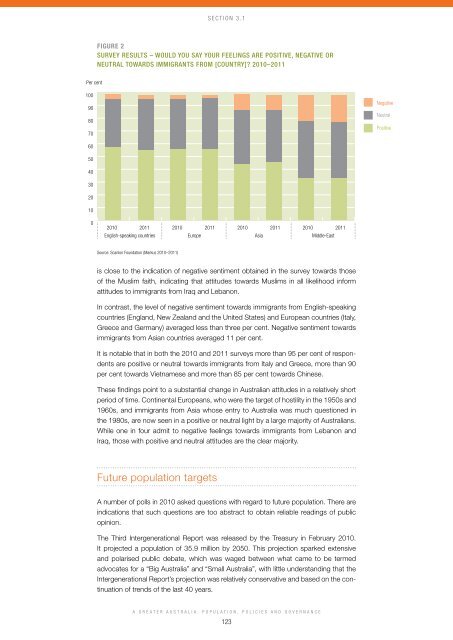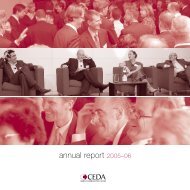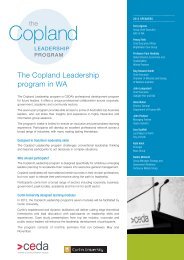A Greater Australia: Population, policies and governance - CEDA
A Greater Australia: Population, policies and governance - CEDA
A Greater Australia: Population, policies and governance - CEDA
- No tags were found...
You also want an ePaper? Increase the reach of your titles
YUMPU automatically turns print PDFs into web optimized ePapers that Google loves.
Section 3.1Figure 2Survey results – would you say your feelings are positive, negative orneutral towards immigrants from [country]? 2010–2011Per cent100908070NegativeNeutralPositive60504030201002010 2011 2010 2011 2010 2011 2010 2011English-speaking countriesEuropeAsiaMiddle-EastSource: Scanlon Foundation (Markus 2010–2011)is close to the indication of negative sentiment obtained in the survey towards thoseof the Muslim faith, indicating that attitudes towards Muslims in all likelihood informattitudes to immigrants from Iraq <strong>and</strong> Lebanon.In contrast, the level of negative sentiment towards immigrants from English-speakingcountries (Engl<strong>and</strong>, New Zeal<strong>and</strong> <strong>and</strong> the United States) <strong>and</strong> European countries (Italy,Greece <strong>and</strong> Germany) averaged less than three per cent. Negative sentiment towardsimmigrants from Asian countries averaged 11 per cent.It is notable that in both the 2010 <strong>and</strong> 2011 surveys more than 95 per cent of respondentsare positive or neutral towards immigrants from Italy <strong>and</strong> Greece, more than 90per cent towards Vietnamese <strong>and</strong> more than 85 per cent towards Chinese.These findings point to a substantial change in <strong>Australia</strong>n attitudes in a relatively shortperiod of time. Continental Europeans, who were the target of hostility in the 1950s <strong>and</strong>1960s, <strong>and</strong> immigrants from Asia whose entry to <strong>Australia</strong> was much questioned inthe 1980s, are now seen in a positive or neutral light by a large majority of <strong>Australia</strong>ns.While one in four admit to negative feelings towards immigrants from Lebanon <strong>and</strong>Iraq, those with positive <strong>and</strong> neutral attitudes are the clear majority.Future population targetsA number of polls in 2010 asked questions with regard to future population. There areindications that such questions are too abstract to obtain reliable readings of publicopinion.The Third Intergenerational Report was released by the Treasury in February 2010.It projected a population of 35.9 million by 2050. This projection sparked extensive<strong>and</strong> polarised public debate, which was waged between what came to be termedadvocates for a “Big <strong>Australia</strong>” <strong>and</strong> “Small <strong>Australia</strong>”, with little underst<strong>and</strong>ing that theIntergenerational Report’s projection was relatively conservative <strong>and</strong> based on the continuationof trends of the last 40 years.A <strong>Greater</strong> <strong>Australia</strong>: <strong>Population</strong>, Policies <strong>and</strong> Governance123





